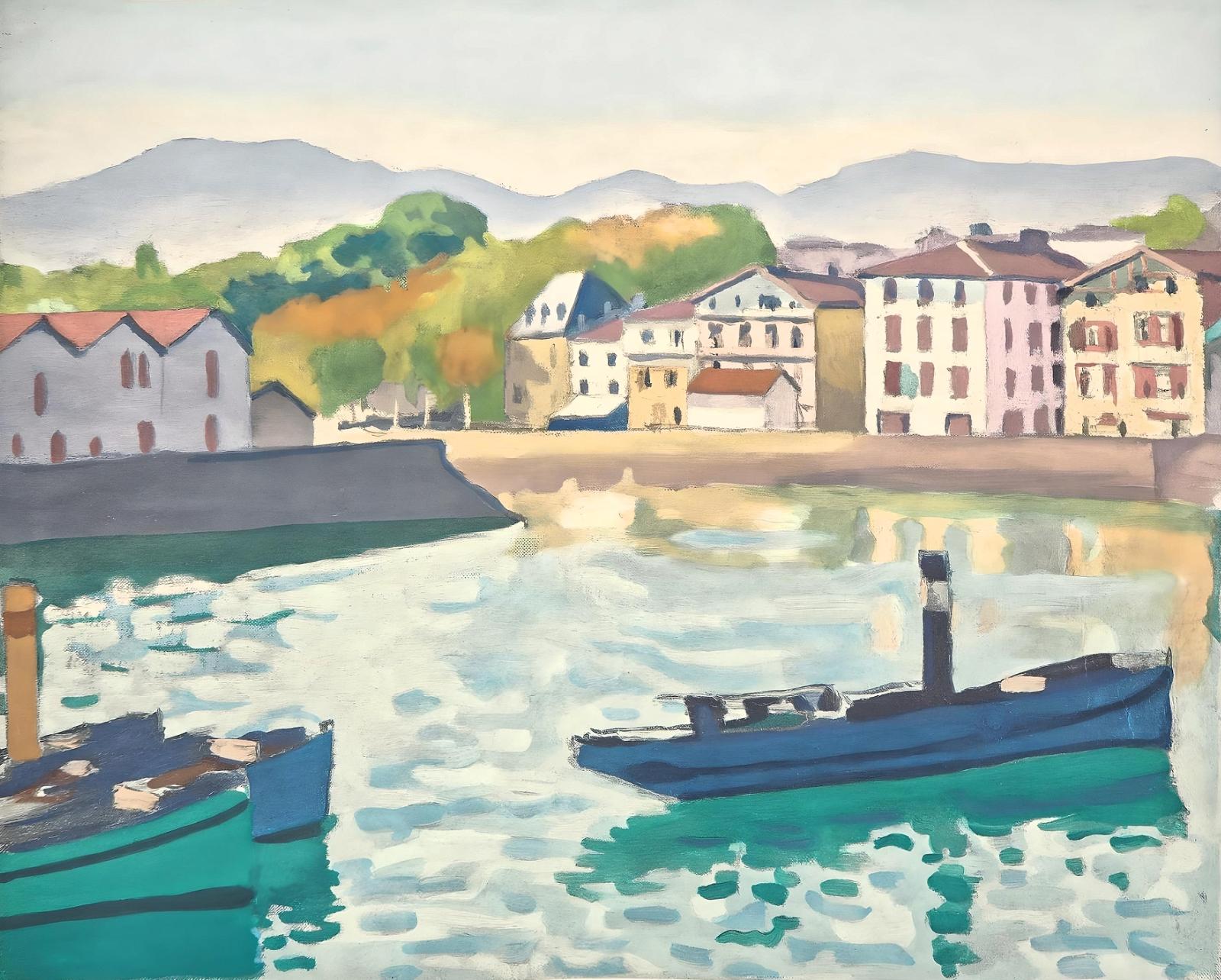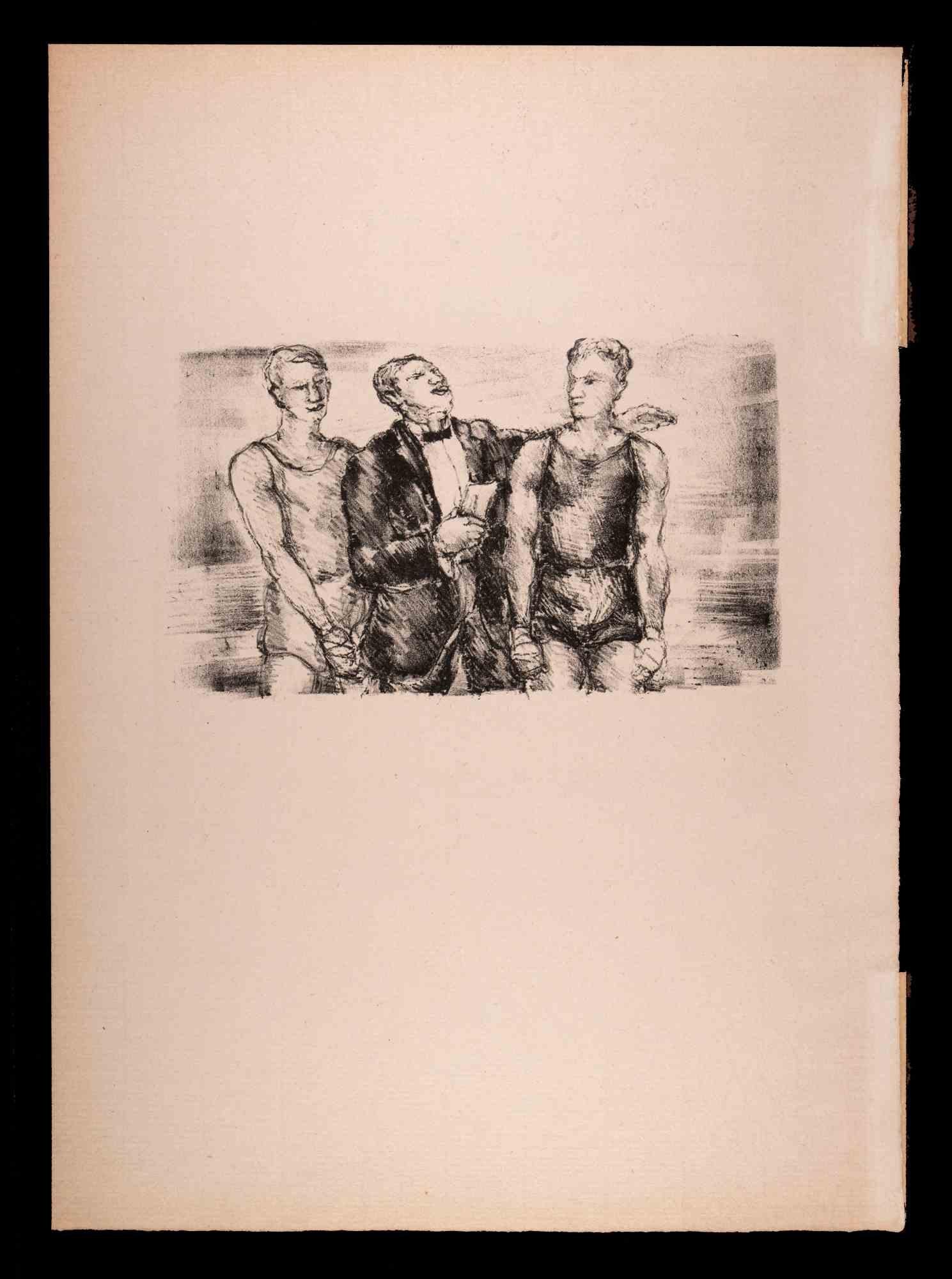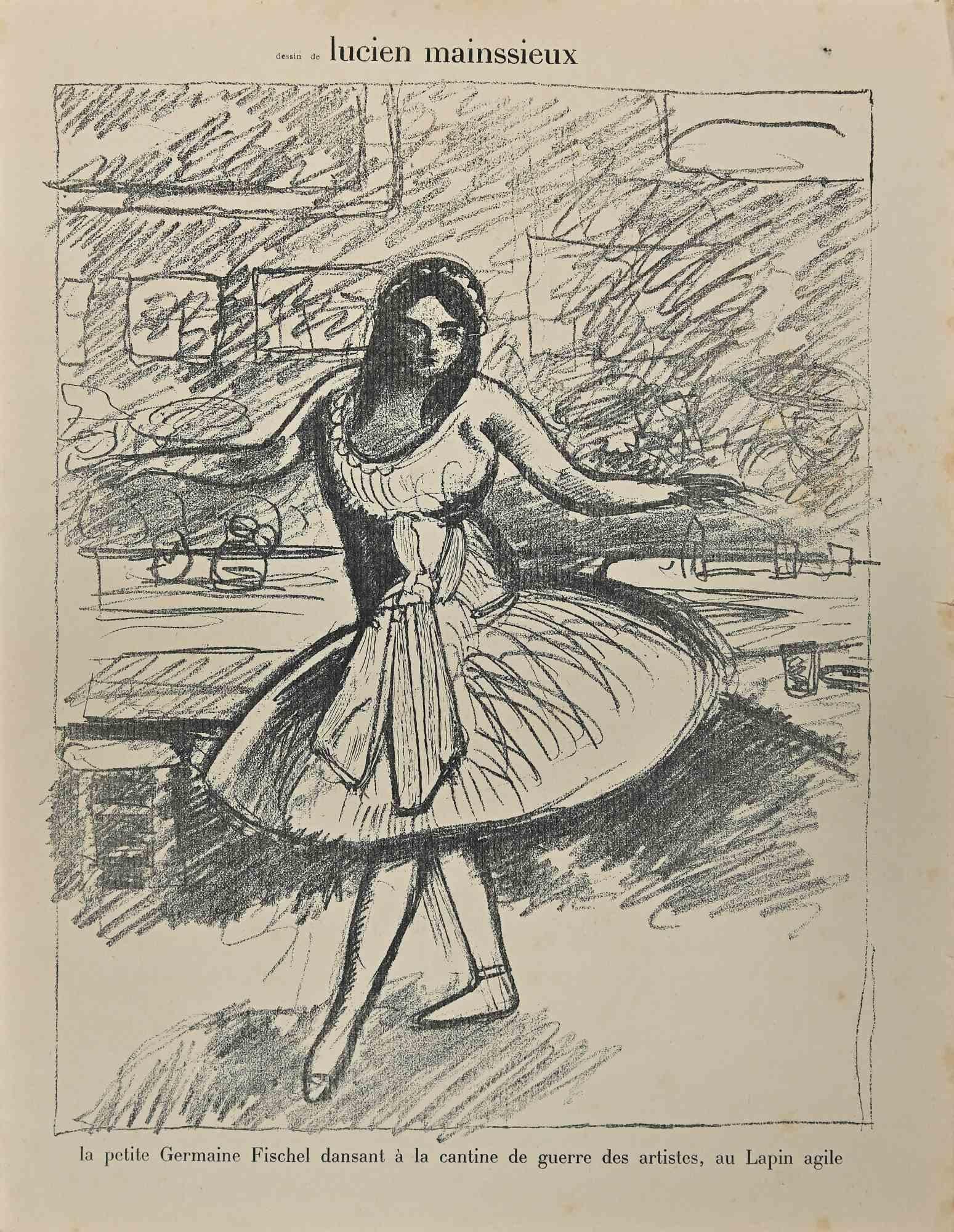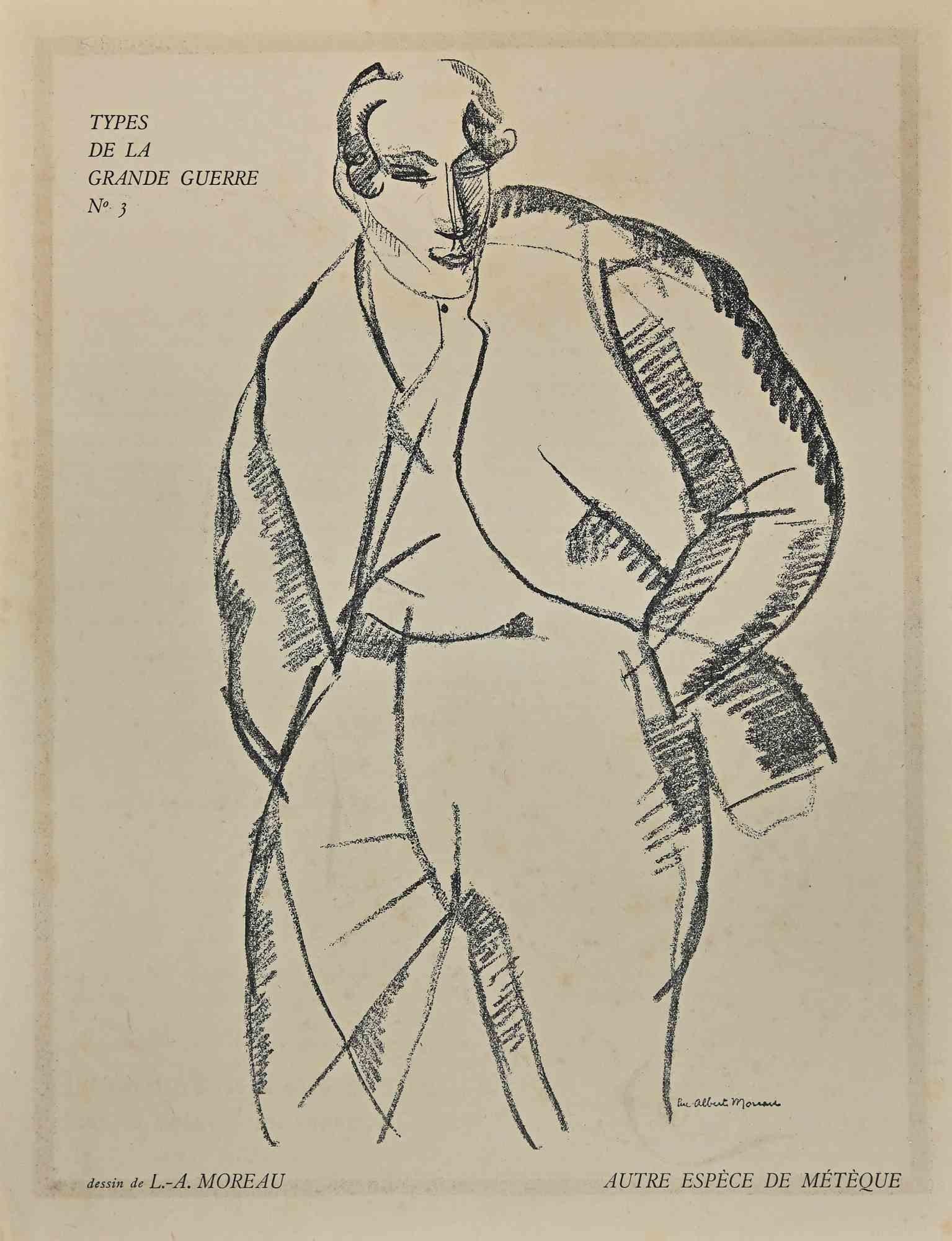Items Similar to Portrait of Woman - Original Etching by Edouard Chimot - Early 20th Century
Want more images or videos?
Request additional images or videos from the seller
1 of 6
Édouard ChimotPortrait of Woman - Original Etching by Edouard Chimot - Early 20th CenturyEarly 20th Century
Early 20th Century
About the Item
Two Figures is an Original etching monotype realized by Edouard Chimot.
The artwork is in good condition on the yellowed paper, included a cardboard passpartout (51x35 cm).
Hand-signed by the artist on the lower right corner.
Represents two nudes women with a white ball.
Édouard Chimot (26 November 1880 – 7 June 1959) was a French artist, illustrator and editor whose career reached its peak in the 1920s in Paris, through the publication of fine quality art-printed books. As artist his own work occupies a characteristic place, but as editor also his role was extremely important in bringing together some of the outstanding talents of that distinctive period in French art and providing the commissions upon which the development of their work in a formal context occurred.
- Creator:Édouard Chimot (1880 - 1959, French)
- Creation Year:Early 20th Century
- Dimensions:Height: 15.36 in (39 cm)Width: 11.42 in (29 cm)Depth: 0.04 in (1 mm)
- Medium:
- Movement & Style:
- Period:
- Framing:Framing Options Available
- Condition:Insurance may be requested by customers as additional service, contact us for more information.
- Gallery Location:Roma, IT
- Reference Number:Seller: T-1304761stDibs: LU65039913452
About the Seller
4.9
Platinum Seller
These expertly vetted sellers are 1stDibs' most experienced sellers and are rated highest by our customers.
1stDibs seller since 2017
6,717 sales on 1stDibs
Typical response time: 2 hours
- ShippingRetrieving quote...Ships From: Monaco, Monaco
- Return PolicyA return for this item may be initiated within 14 days of delivery.
Auctions on 1stDibs
Our timed auctions are an opportunity to bid on extraordinary design. We do not charge a Buyer's Premium and shipping is facilitated by 1stDibs and/or the seller. Plus, all auction purchases are covered by our comprehensive Buyer Protection. Learn More
More From This SellerView All
- Village - Etching by M. de Vlaminck - 1950By Maurice de VlaminckLocated in Roma, ITVillage is a modern artwork realized by Maurice de Vlaminck in 1950. Black and white etching. Hand signed and dated on the lower margin. Edition of 100 specimen as reported on th...Category
1950s Post-Impressionist Landscape Prints
MaterialsEtching
- La ToiletteBy Armand BretonLocated in Roma, ITHand signed. Edition of 50 prints.Original Prints. Image Dimensions : 31 x 23 cm Passepartout included : 69 x 49 cm This artwork is shipped from Italy. Under existing legislation, a...Category
Early 1900s Post-Impressionist Figurative Prints
MaterialsEtching
- Figures in the Landscape - Etching by J. A. Flour - 1916By Jules Adrian FlourLocated in Roma, ITFigures in the Landscape is an original artwork realized by Jules Adrian Flour in 1916. Original etching on paper. The artwork is glued on cardboard. Hand-signed in pencil by the ar...Category
1910s Post-Impressionist Figurative Prints
MaterialsEtching
- La Moisonneuse Endormie - Original Etching by D. de Segonzac - 1929By André Dunoyer de SegonzacLocated in Roma, ITEdition of 60 pieces, printed on verge ancient, numbered and signed by the artist in pencil. Customs stamp on bottom left angle. Good margins. Ref. Cat. Lioré et Cailler 845.Category
1920s Post-Impressionist Figurative Prints
MaterialsEtching
- La neige à Paris (Snow in Paris) - Etching by F. H. Buhot - 1879By Félix Hilaire BuhotLocated in Roma, ITWonderful etching, aquatint, drypoint, and wheel on laid ivory colored paper. Signed inside out on plate on the lower margin at the center. Each image of the composition is hand-titl...Category
1870s Post-Impressionist Figurative Prints
MaterialsEtching, Aquatint
- Jesus Sera en Agonie Jusqu'a la Fin Du Monde - Etching by G. RouaultBy Georges RouaultLocated in Roma, ITAquatint, Drypoint, Burnisher and Roulette. Image dimensions: 58x41 cm Monogram on plate - final state on 5. Edition of 450 prints, belonging to the suite “Miserere”, considered as ...Category
1940s Post-Impressionist Figurative Prints
MaterialsEtching
You May Also Like
- La Loge (The Lodge) /// Post-Impressionist Figurative French Paris People ArtBy Louis LegrandLocated in Saint Augustine, FLArtist: Louis LeGrand (French, 1863-1951) Title: "La Loge (The Lodge)" Portfolio: Gazette des Beaux-Arts *Issued unsigned, though signed by LeGrand in the plat...Category
1910s Post-Impressionist Figurative Prints
MaterialsDrypoint, Etching, Intaglio
- SevillanasLocated in Fairlawn, OHSevillanas Etching and color aquatint on laid watermarked paper, c. 1900 Signed by the artist in pencil lower right (see photo) Editioned in pencil lower left corner of sheet Publish...Category
Early 1900s Post-Impressionist Figurative Prints
MaterialsAquatint
- Figure Reading - Etching - Fauvism - French ArtBy Henri MatisseLocated in London, GBHENRI MATISSE 1869-1954 (Emile Benoît) Le Cateau-Cambrésis 1869-1954 Nice (French) Title: Figure Reading Figure lisant, 1929 Technique: Original Hand Signed and Numbered Etching o...Category
1920s Fauvist Figurative Prints
MaterialsEtching
- La Marchande des Quatres-SaisonsBy Edgar ChahineLocated in Middletown, NYEtching with drypoint on cream wove paper, 11 3/4 x 13 3/4 inches (297 x 347 mm), full margins. Signed in pencil and numbered 32/40, lower margin. Minor mat tone and several small lo...Category
Early 20th Century Post-Impressionist Portrait Prints
MaterialsHandmade Paper, Rag Paper, Drypoint, Etching
- Chatter by Orovida Pissarro - EtchingBy Orovida PissarroLocated in London, GBChatter by Orovida Pissarro (1893-1968) Etching 26 x 19 cm (10 ¹/₄ x 7 ¹/₂ inches) Signed and dated lower right Orovida 1927 Inscribed lower left Trial proof no. 18/25 and titled lower middle Artist biography: Orovida Camille Pissarro, Lucien and Esther Pissarro’s only child, was the first woman in the Pissarro family as well as the first of her generation to become an artist. Born in Epping, England in 1893, she lived and worked predominantly in London where she became a prominent member of several British arts clubs and societies. She first learned to paint in the Impressionist style of her father, but after a brief period of formal study with Walter Sickert in 1913 she renounced formal art schooling. Throughout her career, Orovida always remained outside of any mainstream British art movements. Much to Lucien's disappointment she soon turned away from naturalistic painting and developed her own unusual style combining elements of Japanese, Chinese, Persian and Indian art. Her rejection of Impressionism, which for the Pissarro family had become a way of life, together with the simultaneous decision to drop her famous last name and simply use Orovida as a ‘nom de peintre’, reflected a deep desire for independence and distance from the weight of the family legacy. Orovida's most distinctive and notable works were produced from the period of 1919 to 1939 using her own homemade egg tempera applied in thin, delicate washes to silk, linen or paper and sometimes embellished with brocade borders. These elegant and richly decorative works generally depict Eastern, Asian and African subjects, such as Mongolian horse...Category
1920s Post-Impressionist Figurative Prints
MaterialsEtching
- Man & Beast by Orovida Pissarro - EtchingBy Orovida PissarroLocated in London, GB*UK BUYERS WILL PAY AN ADDITIONAL 20% VAT ON TOP OF THE ABOVE PRICE Man & Beast by Orovida Pissarro (1893-1968) Etching 27 x 22 cm (10 ⁵/₈ x 8 ⁵/₈ inches) Signed and dated lower right, orovida 1924 Inscribed lower left, Final state no 12/40 and titled lower centre Artist biography: Orovida Camille Pissarro, Lucien and Esther Pissarro’s only child, was the first woman in the Pissarro family as well as the first of her generation to become an artist. Born in Epping, England in 1893, she lived and worked predominantly in London where she became a prominent member of several British arts clubs and societies. She first learned to paint in the Impressionist style of her father, but after a brief period of formal study with Walter Sickert in 1913 she renounced formal art schooling. Throughout her career, Orovida always remained outside of any mainstream British art movements. Much to Lucien's disappointment she soon turned away from naturalistic painting and developed her own unusual style combining elements of Japanese, Chinese, Persian and Indian art. Her rejection of Impressionism, which for the Pissarro family had become a way of life, together with the simultaneous decision to drop her famous last name and simply use Orovida as a ‘nom de peintre’, reflected a deep desire for independence and distance from the weight of the family legacy. Orovida's most distinctive and notable works were produced from the period of 1919 to 1939 using her own homemade egg tempera applied in thin, delicate washes to silk, linen or paper and sometimes embellished with brocade borders. These elegant and richly decorative works generally depict Eastern, Asian and African subjects, such as Mongolian horse...Category
1920s Post-Impressionist Animal Prints
MaterialsEtching
Recently Viewed
View AllMore Ways To Browse
Edouard Chimot On Sale
St Georges Chapel
Stained Glass Divider
Star Burst Mid Century
Vintage Stall
Vintage World Map School
Vintage World School Map
Wall Art Water Nude
Prison Bar
Vintage Easter Paper
Vintage 90S Vans
Glass Hair Pin
French Cat Poster
Judith With Head
Parisian Apartment Style
Drum Major
German Railway Poster
Levi Poster Vintage




